Where we are, there is a victory
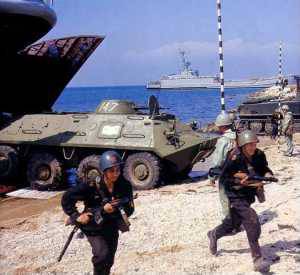 World War II not only became a serious test for the Russian Navy fleet, but also served as the catalyst that accelerated the reconstruction of a special kind of troops - the Marine Corps. During the years of the war, the Marine Corps gained vast experience in conducting combat operations, which, in the part relating to it, was even demanded by the Ground and Airborne Forces, and even more so by the Marine Corps, and individual methods and methods of warfare were included in the "stamped" textbooks on tactics and remain closed to the general public until now.
World War II not only became a serious test for the Russian Navy fleet, but also served as the catalyst that accelerated the reconstruction of a special kind of troops - the Marine Corps. During the years of the war, the Marine Corps gained vast experience in conducting combat operations, which, in the part relating to it, was even demanded by the Ground and Airborne Forces, and even more so by the Marine Corps, and individual methods and methods of warfare were included in the "stamped" textbooks on tactics and remain closed to the general public until now.The basis of these successes was primarily the officer corps - officers for the marines were trained at the Vyborg Marine Corps School, as well as officer courses at the Naval Academy. However, by the year 1956, an “original” thought came to mind: since we have a peace-loving state, the Soviet Armed Forces will not conduct offensive operations with the landing of large naval assault forces, and army units will cope with small landing forces. From this followed a quite logical conclusion - a separate branch of service, marines, is not needed. As a result, units of the Marine Corps were disbanded or transferred to the Ground Forces. It would not be superfluous to emphasize that this decision was made, as eyewitnesses recalled, not only with full consent, but even with the most active participation of Georgiy Zhukov, then USSR Minister of Defense.
Only in 1963, the leadership of the country and the Armed Forces were forced to admit, and this is largely the merit of the commander in chief of the Navy, Sergei Gorshkov, that the marines are needed. From this moment began the countdown of the newest stories marines. The first was formed a separate regiment of marines in the Baltic Fleet, and then the process went on increasing - MP regiments were formed in the Pacific and Northern fleets, and then a battalion, later expanded to the composition of the regiment, in the Black Sea Fleet. By the end of the 1970-ies, the structure of the MP Navy assumed the form, which in principle, with separate reservations, has been preserved to the present.
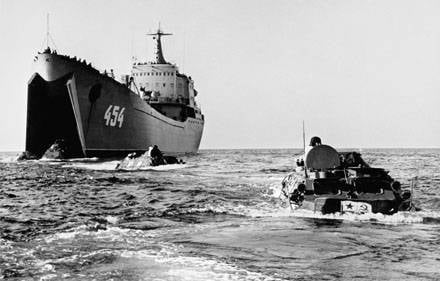
From Egypt to Angola
The Cold War was such only on paper, in fact, the tension of its battles was a little less than the "hot" war. The Marines took an active part in long trips and were often involved in specific tasks. Our marines had to visit many corners of the globe: Egypt, Syria, Ethiopia, Malta, Greece, Angola, Vietnam, India, Iraq, Iran, Yemen, Madagascar, Somalia, Pakistan, Benin, Guinea, Guinea-Bissau, Sao Tome - you won’t list everything. The Soviet "black berets" had to pacify both the separatists and the terrorists. As it was in Ethiopia, where a company of marine corps reinforced tank platoon, landed in the port of Massau and entered into combat contact with the separatists who ruled in the city. In the Seychelles in November 1981, the marines under the command of Captain V. Oblogi prevented an attempted coup.
Our marines have contributed to the independence of Egypt, although few people already remember this. But in Port Said, the Marine Corps battalion for several days in the morning held positions in the second echelon of defense of the Egyptian army, covering its rear, and in the evening returned back to the ships. However, our marines did not have to participate in the hostilities. As the former chief of the coastal forces of the Navy, Lieutenant General Pavel Shilov recalled, “with the advent of the first Soviet landing ships at Port Said, the Israelis ceased to take any active action in the nearest border zone, although before that the city and the positions of the Arab troops around it were repeatedly raided the enemy aviation and shelling. "
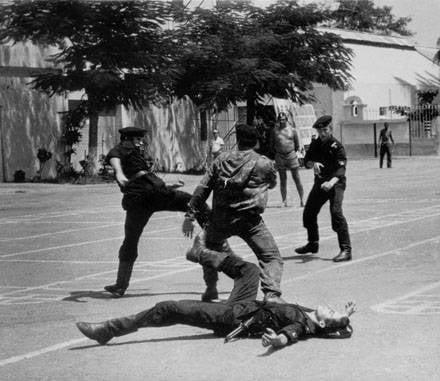
In fact, since 1967, combat service for the Soviet marines in the oceans has become regular. The Navy's MP units carried it primarily onboard the 771 medium landing craft — a reinforced marine corps with weapons and military equipment, as well as large 775 landing craft — as part of a reinforced marine company (the capacity of such ships was up to 12 armored vehicles), or 1171 and 1174 project - as part of a reinforced battalion of marines (the capacity of ships, respectively, is up to 40 and up to 80 units of various armored vehicles, including main battle tanks). Sometimes such combat services lasted for half a year or more, and in March 1979 of the year, for example, the 1 Battalion of the Marine Corps of the 61 Regiment of the Marine Corps of the Red Banner Northern Fleet (commander of the landing force Major A. Noskov) was sent to combat service of record duration - 11 months. What surpasses most of the autonomous navigation of nuclear submarines.
Another example. In August, the PT-1987 amphibious tank company from the separate tank battalion (opt) of the Northern Fleet 76 Brigade of the Northern Fleet made the transition afloat through the open ocean from the Bay of the Nizhnyaya Titovka Bay to Kutovaya Bay, skirting almost Rybachy peninsula (it's not clear - just look at the map!).
Hard to learn - easy to fight
Marines took an active part in various exercises. For example, in the summer of 1981, the battalion tactical group of the MP of the USSR Navy under the command of Lieutenant Colonel V. Abashkina at a joint Soviet-Syrian exercises successfully carried out an assault landing in an unfamiliar area - in the area of the city and the Syrian Lattakia base station. And then our marines advanced deep into the territory, into the desert and suppressed the resistance of the enemy.
In 1985, a battalion of marines from the Baltic Fleet was put on amphibious ships, which made the transition from Baltiysk to the Rybachiy Peninsula in the North. There they landed on the move to an unfamiliar training ground, completed the task, and then made a return landing on the landing craft located at a distance from the coast and returned to the place of permanent deployment by sea.
In 1982, the “Ray” exercise was conducted in the Pacific Fleet, in the framework of which, under conditions as close as possible to the fighting, from the ships to the coast reinforced by the enemy, a large naval landing was carried out. The uniqueness of the teaching was that it happened at night without using any lighting fixtures. Control was carried out only with the help of infrared equipment. And this is almost thirty years ago!
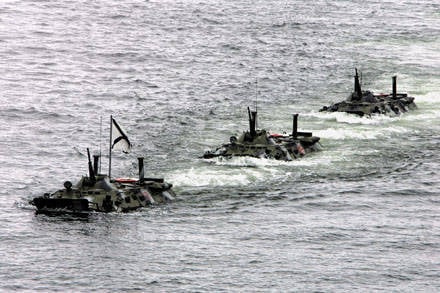
According to the memoirs of Rear Admiral Cyril Tulin, who served in the division of amphibious assault forces KTOF in those years, the landing of the landing force on the ships also took place at night. The ships were landing with the lights turned off, using only IR equipment. Crews use of communication is strictly prohibited, as well as committing the march. Commanders could only use protected lights.
The landing forces and fire support ships numbered more than fifty units of various classes and types (projects). They were divided into two amphibious detachments and a detachment of support. The transition to the landing site in the Vladimirskaya Bay of the Ussuriysky Bay was completed in three days. At the appointed time, at night, the detachments approached the landing site. Of all the lights, there are only “glowing” aerial bombs hanging in the air, with the help of which attached naval aircraft illuminated the “processed” targets. No sooner had the land settled from the ruptures of the last bombs, how did the fire support ships move forward. And the earth reared again. Then the landing ships quickly passed through the formation of support ships, and the actual landing of the landing began.
Airborne assault units of the Marines on assault boats of the 1206 air cushion project (such as Kalmar), which were launched from the large-capacity BDK Ivan Rogov and Alexander Nikolaev, went to the bridgehead. And for better orientation, the paratroopers were given torpedo hydrofoil boats. Hundreds of fighters rapidly left the landing craft and ships, in turn capturing the defensive lines of the enemy. And all this in total darkness! As far as the author knows, no such event was held in any country of the world. Even in the United States, in which the number of marine corps is ten times higher than the Russian.
But a year later, in June 1983, an even larger exercise was held on the Black Sea. For the first time a team of marines in full force landed at night on the water with simultaneous release of parachute assault. According to the recollections of the participants of that doctrine, about two thousand marines (including reservists who were called up from the reserve), who had up to four hundred units of various equipment, went from the sea and from the skies to the bridgehead.
The level of training of our marines, Tommy and the Yankees could see for themselves during the joint Anglo-American-Russian exercises RUKUS-1996 held in the UK in April-May 96 of the year. A group of marines of the Northern Fleet under the command of Senior Lieutenant I. V. Durnov was sent to participate in the exercises.
Нmarketing Caucasian wars
The first and second Chechen wars, in which the “black berets” took an active part, became a special, dramatic and heroic period in the history of the marines.
For the Russian Marine Corps, the Chechen war began on January 7, 1995, when, in accordance with the directive of the General Staff of the Russian Armed Forces, two separate air assault battalions of the Northern and Baltic fleets were deployed to the Caucasus, and then a regiment from the Pacific fleet. "Black Berets" immediately thrown into the most difficult areas.
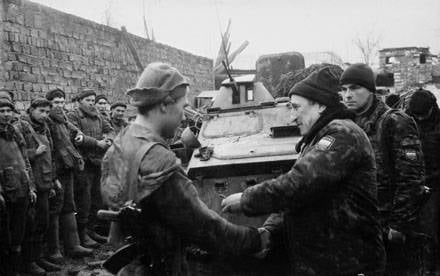
The first battle with Dudayev’s “polar bears” came on January 10 on the outskirts of Grozny. In the course of fierce fighting in urban conditions, the personnel of the school during the period from January 10 to March 7 1995 captured key objects such as the building of the Central Post Office, the Puppet Theater, the Kavkaz Hotel, the building complex of the Council of Ministers and the Presidential Palace of the Republic, Minutka Square and others whose names are constantly flashed in newspapers and television reports. "Black berets" in gold letters inscribed their names in the Book of Glory of the Russian army. The victory, however, came at a high price: only from the North Sea people 56 people died, and 120 were injured of varying degrees of severity. Marines from the above-mentioned 879 squadron of the 336 Guards Region of the Baltic Fleet and the 165th Marine Regiment of the Pacific Fleet MPN also took part in the battles for Grozny.
Then, after the fall of Grozny, the consolidated regiment of the MP Navy, consisting of North Sea, Pacific and Black Sea (in the 106-th regiment of the 55 division of the MP of the Pacific Fleet were included separate battalions of the marine infantry 61 and 336-th brigade of the marine infantry of the Northern and Baltic fleets), two more months, before 26 June 1995, destroyed the militants in the Vedensky, Shali and Shatoi districts of Chechnya. During the fighting, more than 40 settlements were freed from militants, a large amount of heavy weapons and military equipment were destroyed and captured. But here, unfortunately, it was not without losses, although they were much smaller. In total, 1995 marines were killed and 178 were injured of varying severity during the 558 battles of the year in Chechnya. 16 people received the title of Hero of Russia (six - posthumously).
After the invasion of extremist Wahhabis on the territory of Dagestan and the start of the counterterrorist operation, the reinforced 876 th odbb from the 61 brigade of the marines of the Northern Fleet in the period from 10 to 20 September 1999 of the year again departed to the North Caucasus. The battalion was transferred to the Caucasus in full force, with the means of strengthening. On September 30, after the combat coordination of the units, the battalion advanced by marching, first to Khasavyurt, and then on the route with the final destination, the village of Aksay. The march was held in conditions of almost constant fire contact with the enemy, the first killed and wounded appeared in the battalion. But the onslaught of the marines continued unabated, and in November one of the main strongholds of the militants was taken - the city of Gudermes. Then there were settlements Botlikh, Alleroy, the Andes and others. In addition to the North Sea forces in the counter-terrorist operation 1999 – 2000 in the territory of Chechnya and Dagestan, the reconnaissance of the 810 of the Black Sea Fleet and the 414 of the Caspian Flotilla took part. During the operation, 36 marines were killed and 119 were injured. Five "black berets" was awarded the title Hero of Russia, including three - posthumously. Moreover, the four Heroes and all three who received this title were posthumously served as military personnel of the 61-th separate brigade of the Northern Fleet Marine Corps, and in just two Chechen wars only the Northern Fleet Marine Corps lost killed and dead in the post of a single general, seven junior officers, a senior ensign and 73 sailor and sergeant.
After the group of forces of the marines created in the Caucasus had completed its tasks, the units began to be withdrawn from Chechnya in turn, the group was disbanded. Of the marines, only the Caspian battalion remained there, but it was also withdrawn at the end of September 2000. However, already in April, by the decision of the command, the battalion of the Caspian MP brigade was sent to block the border between Dagestan and Chechnya, and from June 2001 to February 2001 in the mountainous regions of Chechnya and Dagestan, the tactical group of the Caspian brigade of marines was active on a permanent basis. . And even after the withdrawal from the republic of the bulk of the troops that took part in the last
the counterterrorist operation, for another six months, the mountainous sections of the administrative border of Chechnya and Dagestan, as well as the state Russian-Georgian border, were covered by a battalion tactical group from the youngest brigade of the Navy MP. For a long time, the Caspians had to operate in almost completely autonomous mode, apart from the main forces and supply bases. But the "black berets" coped with the task entrusted to them. Subsequently, the number of marines on a permanent basis operating in the Chechen Republic, was reduced from the battalion to the company, and then the "black berets" completely returned to the place of permanent deployment.
In many ways, high command and combat skills of the Marines were achieved by their command due to the transition in the first half of the 1990-s to the new organizational structure, which meant: each company, each battalion, unlike the ground, should be able to perform tasks independently, apart from the main forces, due to the very purpose and nature of the actions of the marines. For example, the battalions of the Marine Corps were given permanent artillery, a mortar platoon, a communications unit, which ultimately made a type of miniature regiment out of a typical marine battalion. All this allowed the use of marine units in the Caucasus with high efficiency.
It was also helped by the “black berets” that the units of the marines as a whole constantly worked out and continue to work out the elements of combat at different grounds and in different conditions, the benefit of the marines has accumulated sufficient. And indeed, it is really not known beforehand in what conditions and on which coast the marines will land in the landing, where they will have to fight, in what conditions: in mountainous terrain, in the plain, in the jungle, in the desert or in settlements. Even in Russia, the landing of amphibious assault forces in rocky or mountainous areas is possible in several areas - in the North, the Far East or on the Black Sea coast of the Caucasus. The same can be said about combat in urban conditions, since even the experience of the Great Patriotic War and the Korean War showed: the marines can and must land directly in the port city, seize a bridgehead and hold until the main forces arrive.
Interestingly, the former head of the Marine Corps of the Russian Navy, Colonel Yuri Yermakov, recalled: Marines of Great Britain and the United States were actively interested in the experience of the Russian marines in fighting in urban conditions in the 1990s. It was not by chance - subsequently the knowledge gained was applied by the British and American marines to practice in Yugoslavia, Iraq and Afghanistan.
The future is seen through reforming.
Currently, even despite the reform and downsizing, the marines remain one of the most important components of the Russian Navy. Organizationally, it is part of the coastal troops of the Russian Navy, and the direct command of its activities in peacetime and wartime is carried out by the head of the marines. There are parts of the marines in all fleets - in a separate brigade of marines, in the Caspian flotilla (separate battalions) and even in Moscow (military support units and guards of the Navy Main Headquarters), they report in the field to the heads of the coastal forces of the Baltic, Black Sea, Northern and Pacific fleets.
The long years of underfunding and constant reforming of the Armed Forces also affected the marines. Literally, living states are being cut, there are not enough professionals, including contract servicemen in sailors' positions, armored vehicles are thinning and, what is even more threatening, the number and combat potential of the landing forces of the fleet are reduced.
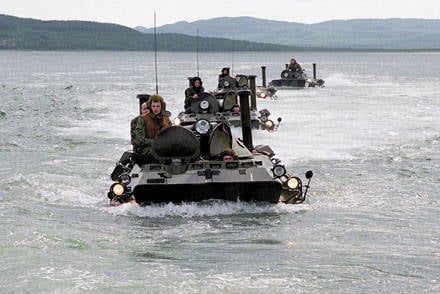
For example, Russian marines today have virtually no floating armored vehicles capable of landing on an unequipped shore in the first echelon of the amphibious assault, floating, ensuring the suppression of the fortified points and positions of enemy fire weapons (including firing from the water). All that we have today can "float" from military equipment, these are armored personnel carriers of the BTR-80 family and armed with MT-LB machine gun installations (you shouldn't mention the floating conveyors armed with machine guns). A very good armored vehicle, the BMP-3 F, which is armed not only with rifle guns, but also missile weapons, the 100-mm cannon and the ATGM launcher, the 30-mm automatic cannon and three machine guns reached But received high reviews from the UAE military ground forces. Tested in the Marine Corps and adopted 125-mm self-propelled anti-tank gun 2 С25 "Sprut-SD" is also absent in the required quantities.
As acknowledged by the commanding staff of the Russian marines, so far a worthy change to the retiring floating tank PT-76, which is capable not only of floating, but also firing from the water, has not appeared. The existing tanks of the T-72 family can, as is known, be landed from landing ships only on the stop or in an equipped port - as well as the Gvozdika and Nona-S and Nona-SVK self-propelled installations, mobile air defense systems and other military equipment. But the same Americans, who are considering the possibility of landing an amphibious assault actually only on an already well-treated coast, with suppressed resistance from the enemy, more than five years ago began to create a floating armored vehicle with good seaworthiness and powerful enough weaponry and capable of just suppressing fortified firing points in the antiamphibious defense of the enemy.
Some time ago it seemed that a way out was found - Moscow’s Special Machinery and Metallurgy OJSC proposed a modernization option for the PT-76, in which it was supposed to install a new turret with an 57-mm automatic gun mounted on it (reworking the AK gunboard -725 conducted Nizhny Novgorod CB "Petrel"), a new automated MSA and two-plane weapon stabilizer. The combined sight, developed by one of the Belarusian optical-mechanical enterprises, was equipped with a built-in rangefinder, and the new weapon system would provide the upgraded tank PT-76 B with a threefold increase compared to its predecessor firepower. For example, when firing an armor-piercing tracer projectile at a distance of 1250, the gun penetrates armor with a thickness of 100 mm.
In addition, in order to increase the mobility of a new tank on land, specialists from the Volgograd Tractor Plant design bureau developed a modernization program for its propulsion system: a more powerful UTD-23 diesel engine and transmission used on the BMD-3, as well as new tracks with better grip properties are being installed and a great resource of exploitation. An additional possibility of survival of the upgraded machine on the battlefield is designed to give a special system for scanning and detecting optical devices, which is similar to devices for detecting snipers. True, the matter did not go further than the proposals - either there was no money, or such equipment wasn’t necessary for the marines.
However, if the equipment has lately, at the very least, gone to the marines, then some actions of reformers in the field of reorganizing the organizational structure of the marines of the Russian Navy simply do not lend themselves to any logic. Thus, for example, the 77-th separate Guards Moscow-Chernigov Order of Lenin, the Red Banner, the II Order of Suvorov, II degree, the Marine Corps Brigade of the Caspian Flotilla, created in 1996 on the basis of the 600-th Guards and 414-separate naval infantry battalions was disbanded. From 1 December 2008, the brigade ceased to exist, and its personnel, equipment and equipment, with the exception of two battalions of marines with bases in Kaspiysk and Astrakhan, were transferred to a separate brigade of the marines newly formed in the Black Sea Fleet.
The fact that, on the basis of the 810 of the OppA, in 2008, the abbreviated exactly 10 years before the Black Sea brigade of the marines (810 obrmp) was recreated could not but rejoice, but was it reasonable to do so by eliminating another compound, and on such an important direction, like the Caspian Sea, where until now Russia has not managed to reach a mutual understanding on the issue of delimitation of influence on the sea with its neighbors in the region? Many experts have long called the Caspian just as “the sea of discord,” but in Moscow they decided that they would not need marines there. Our military leaders love to attack the rake several times ...
A similar, not entirely positive, reorganization was carried out with respect to the Pacific Fleet Marine Corps. Not only a dozen years ago, at the top, it was suddenly decided that the 55 Division of the Marine Corps located in the Far East did not need a separate tank regiment, disbanded the latter (as representatives of the command of the division told me, the unit lost all T-55 tanks, and not quite modern, but still tanks), so quite recently it was decided to reduce the division itself - from 1 June 2009, it was reformed into the 165-th separate brigade of the Marine Corps of the Pacific Fleet. And this is despite the fact that in the Far East, Russia has potential, if not opponents, then competitors - China and Japan. Moreover, it is necessary to take into account the fact that one of the primary tasks of the Pacific Marines was to capture the pouring zones in order to ensure that the main forces of the Pacific Fleet, which are based on Kamchatka and in some other “open “To the ocean, coastal areas are literally locked up in the Sea of Japan (see where Vladivostok and Sovetskaya Gavan are located — significant forces of the Pacific Fleet are based there).
In general, by and large, it is criminally to reduce forces in the Far East, and it is doubly criminally to reduce the already few marines.
However, the situation in other fleets is no better either - in the Russian Navy today there are only four brigades of marines left: the already mentioned 165 I brigade, the 336 I separate Guards Belostok Order of Suvorov and the Nakhim Brigade of marines of the Baltic Fleet, XNUM The Separate Kirkeness Red Banner Marine Corps Brigade of the Northern Fleet and the 61 I Separate Marine Brigade of the Black Sea Fleet, as well as several separate regiments, battalions and companies. And this is for the entire fleet, whose task is to defend from the sea areas of the vast length of the coast of Russia and to assist ground forces in conducting operations on coastal theaters.
Information